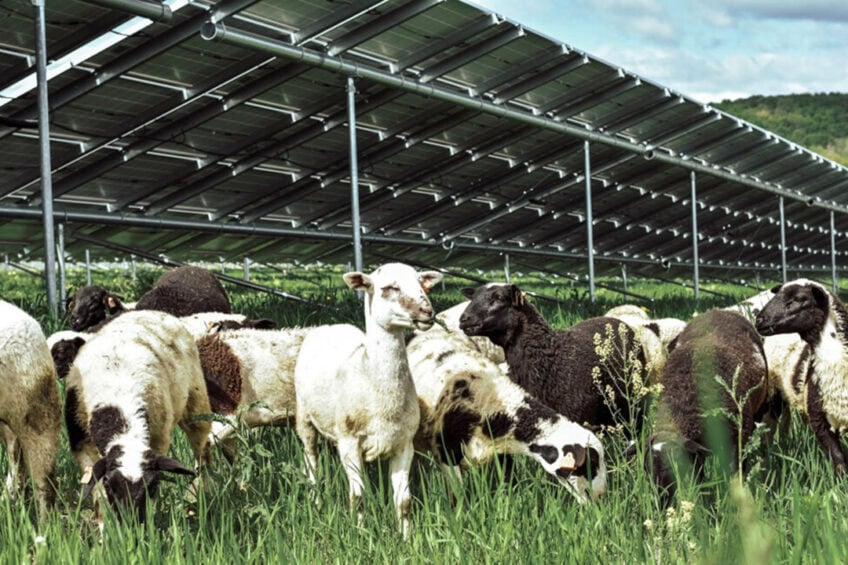Harvesting crops – and sunlight

Can large-scale, on-farm solar power help solve global energy and food crisis?
Sunlight is the most abundant source of energy. According to Claude Mindorff – Alberta-based energy consultant and director of development for renewable energy company PACE Canada – the large-scale incorporation of solar panel systems into working farms could simultaneously support more cost-effective and bountiful food production, negate agriculture’s carbon footprint, and better ready the rural landscape for economies without fossil fuels.
Agrivoltaics
There’s a term for the large-scale blending of solar energy generation and farming. It’s called “agrivoltaics,” and Mindorff’s background in infrastructure construction through the dry regions of southern Alberta highlighted the opportunity of using solar energy to power crop irrigation. The physical nature of solar systems, however, could also be useful in other ways – both agronomically, and as a wider solution to society’s green energy needs.
“When you install a solar field, there’s a lot of communication – from the invertors, to the switch gear, to the grid, and to the owner of the field for operations and maintenance,” says Mindorff.
“That telemetry can be piggybacked with soil monitoring equipment, moisture monitoring, nutrient management…it creates a sustainable practice for the next generation of farmers.”
Generate and store power
That sustainable practice extends to powering what is the increasing electrification of farm equipment. Additionally, the ability to generate and store substantial quantities of power in working fields and pastures could help alleviate the problem of providing electric charging stations in remote areas. Speaking within a Canadian context, the Electric Car Charging Association in Canada estimates the country will eventually need 1.2 million charging stations in the country. The federal government, however, is only sponsoring 65,000.
“If those charging stations existed at virtually every farm, your neighbour who is the farmer could put his charger out by the roadside near his fence line and provide electric charging in rural Canada,” he says.
“In the Canadian agrivoltaics effort, we’re trying to provide distributed energy resources that can power all of our human activities wherever we live…This isn’t about developers seeking licence to develop on agricultural soils. This is a group of like-minded individuals who are trying to apply science to increasing renewable energy that comes from agriculture. First to displace what agricultural users do, but then to provide part of the bigger solution.”
Text continues below image

Practical challenges
There are challenges, of course. Not every farm and field are the same. Crop needs, production methods, rotations, and the spaces required for farm operations vary wildly. How mass solar infrastructure looks on a given farm, therefore, would need to be adapted to unique conditions.
The systems employed over broad acreage irrigated corn production, for example, might be peripheral around the field, or spaced with room enough to allow the easy operation of large farm machinery. Conversely, Mindorff says more closely constructed panels providing partial shade would be useful for fruits and other higher-value crops, later highlighting examples of such systems currently employed in both Arizona and Germany.
“Each of the applications takes into consideration the farmers needs and the farming they’re involved in,” he says. “We’re not asking farmers to adopt field practices…solutions are really out there.”
Infrastructure
Solar farming is, of course, not necessarily something that will or can happen everywhere, and doing so on a large scale on agricultural land is a tall order. When asked why the focus is not getting solar panels over existing infrastructure not directly producing agricultural goods (agricultural or otherwise), Mindorff reiterates that should also be part of the effort, and that many farmers are already taking advantage of solar to address their own business needs.
“In actually fact, agrivoltaics addresses the needs of society. We need more renewable energy, and if we don’t find ways to build it in a sustainable fashion, we’re going to see a backlash…Primarily it’s a cost factor. When you’re putting something on a roof, it’s $2.00 to $3.00 dollars a watt. When you put it on the ground it’s $0.85 to a dollar a watt, so it’s much more cost effective for ground-based systems as it is for rooftop systems. Does that mean we shouldn’t do both? Absolutely not. We should do both.”
Policies supporting individual ownership and distribution of large scale agricultural solar projects are also required. To this end, Mindorff speaks to new efforts with London Ontario’s Western University to show industry and government the potential of agrivoltaics, and what policies are required to achieve that potential. Indeed, a working group has been established to theorize, and subsequently trial, different systems on different types of farms. The working group’s initial planning meeting is, at the time of this writing, set for autumn 2022.
Join 17,000+ subscribers
Subscribe to our newsletter to stay updated about all the need-to-know content in the agricultural sector, two times a week.



